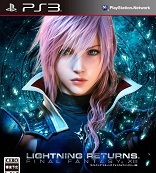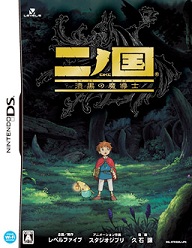Dungeon Explorer: Warriors of Ancient Arts
Nintendo DS
Reviewed: 03/08/2008
 Dungeon Explorer: Warriors of Ancient Arts for the DS is the first game from Hudson’s dungeon crawling property to be made since 1994’s Dungeon Explorer for the Sega CD. The series has come a long way from its roots as a Gauntlet clone – now it’s a Diablo one.
Dungeon Explorer: Warriors of Ancient Arts for the DS is the first game from Hudson’s dungeon crawling property to be made since 1994’s Dungeon Explorer for the Sega CD. The series has come a long way from its roots as a Gauntlet clone – now it’s a Diablo one.
Dungeon Explorer’s setup revolves around the Demon God Breed and the temple he is sealed in. The game’s lone city of Confine is built around this temple. As a result, the town sees a lot of adventurers passing through it to challenge the temple and become stronger. Others have come looking for power. One of these power-seeking groups raids the temple and causes a both a local and geological uproar. Directly after this, monsters appear and the kingdom of Westria sends troops to investigate. No one knows what happened to the troops, but somehow zombies appear and the lord of the land is implicated. The court then turns to adventurers to help the kingdom in order to stem their military losses. The main quest involves the player hunting down the temple raiders and ensuring they do not cause the kingdom further harm.
The plot is nothing new and, like a porn star’s G-spot, barely there over the course of the game. Players move the plot along by accepting quests from the local captain. Each quest is put into the quest log and can be referenced at any time. The story is excessively linear and contains few side quests; most of which are found in the dungeons the player is already exploring. Back story is told throughout the game using stone tablets, with the shape of each tablet determining the point of view it harbors – ‘tombstone’ style for good, red and black for bad, and others for others. There is some mythology to be found here, but like the story it is generic and easily ignored. The options menu contains a quick reference guide and glossary for those interested. The last thing to be said for the overall story is that the localization did not seem to be important. Too many times was a female warrior called ‘boy’ by the boss characters, and lots of terms and names are thrown about without much care. The game is actually a story being told by a goblin, but it only references this on a few occasions.
The player creates their own character and the story relies on its blanketed nature to move along the game’s design – hacking and slashing. There is the choice of three races to beat up enemies with: men, women, and steel farmboys. Each of the three races contains a mage class, a melee class, and a ranged class. Race affects the starting stats while class further affects the stats and attacks skills. The combination of both affects the type of weapons the character may wield. Every level up gives the player three points to distribute among their vitality, arts, strength and dexterity. Most points will flow into vitality to maintain not dying while strength and dexterity ensure equipment can be used and more items can be carried. Mages will throw a few into arts to up the amount of spells that can be cast. This character customization falls short when most of the player’s points have to go into one area in order to survive a hit from a boss.
 |
Combat is real time. The player runs around a field smacking enemies repeatedly until the enemies die. The player can use their skills, weapons or items to slaughter the repetition of enemies. There are generators which will spit out additional, smaller enemies, but these enemies are barely worth the effort and destroying the generator will reward more experience. It will also remove the spawned enemies from the field. The only notable addition is a strength gauge. When it is at max, the character will hit their hardest and activate their chosen addition skill, a la Secret of Mana but with one weapon level.
Skills are called ‘arts’ and are learned during one of the startup quests. Despite starting with class-based arts, the player does not gain access to these arts until they acquire a ‘school.’ These schools contain most of the arts a player will use over the course of the game. A school is gained by using a roulette wheel that chooses between one of the game’s eight different schools. The player is given little prior knowledge of the arts each school has and the decision is irreversible until near the end of the game. The arts given to players are unlocked by defeating enemies with other arts. The first arts are always the school’s inherent additions. These additions are the arts which activate when the strength gauge is at max. Each school has two additions: one for attack and another for defense.
Enemies are numerous with their AI either set to dogpile or stupid. Many times can an enemy be exploited by catching them on a corner and bashing them to death. If a player dual-wields, then solo creatures are can be juggled with few repercussions. The main quest never really becomes hard. It just becomes cheap. After the first few quests, the bosses start teleporting around the room and become hard to hit. When their pattern dictates they stop, they shield themselves from attack or present a small window of opportunity to smack them. They also have one insanely powerful, multi-hit attack that disrupts the action of using a heal potion. Boss fights become tedium. Every boss fight plays put like it was patterned after FF12’s final boss. It’s annoying.
Killing enemies leaves behind items and equipment. Items are of the standard one-shot use variety (restoration, curative, warping out of the dungeon and bombs) while equipment varies consistently. There are standard pieces for equipment, but most of the time equipment has different enchantments that affect its stats. Some equipment will need to be appraised and cannot be equipped right away.
 |
The adventure can be a solo one, or the player can grab a robot buddy to come along. The Owon are little mechanical eggs that help damage creatures but mostly get themselves killed. Their use is limited until they can be upgraded, at which point the game becomes pathetically easy. This is despite the robot’s insistence to get caught behind objects or be a target for gangbang. Thankfully, there is an option to either make it follow you (ideal for bosses) or do its own thing (ideal for everything else). These options help cut down on robot dying for a little bit.
The gameplay is repetitive because it’s a dungeon crawler. Outside of bosses, it is also easy. There is one decent reward for going through the game – Hard Mode. Hard Mode can only be unlocked when the main quest is over and the villagers express interest to the player about slaying the Demon God in the temple. They can either venture into the final and optional dungeon to do so, or the player can listen to a local legend and head there to restart the game. Hard Mode allows all earned levels and equipment to be carried over, but not the arts. If the player does regain the same arts they had previously, then the arts’ level will remain intact. Hard Mode is also hard. Enemies that were walked over at level one now take multiple hits at level 52. Spamming generators to gain experience is initially a good idea until a new enemy pops out – a Steel Wisp of immeasurable strength that can only be killed by destroying the generator. Hard Mode also contains new armor and weapons. It’s a definite prerequisite if the player wants to try the lackluster Wi-Fi or attempt the temple’s boss.
The Wi-Fi is a simple match-up of levels marred by very few people playing. The players on are also around level 99 and have completed the game multiple times; only going online to beat the time trials the online mode represents. True to Nintendo fashion, Friend Codes hamper any game that does not involve them. There is also a slight bit of lag and an enemy that was being fought somehow escapes the player and has to be re-engaged – typically in the midst of other enemies. These factors make it hard for a level 56 character to break in and give it a try.
Graphically, the player may need a few beers and a centerfold of FF12 before approaching the game in earnest. The sprites are grainy, the character portraits generically anime, and the enemies consistently palette-swapped. Even the bosses are palette swaps of each other three-quarters of the time. To drive this point further, on the publisher’s website most of the screens shown are from the PSP version which has 3D graphics. They did include the ability to swap which screen the game plays on, which is a huge bonus when combating glare.
The music was initially disappointing after listening to Dungeon Explorer II’s ‘Running in the Dark’ and ‘Under Sea Caves.’ Plugging in a set of headphones will reveal that the tracks are fairly decent and fit the dungeons well, though forgettable the moment the game is turned off.
The gameplay is repetitive and has been done several times in the past by better games. The game is short and linear with little exposition. The graphics are just up to GBA standards and the Wi-Fi is almost laughable without friends. And the bosses are cheap. However, there is something here. The dungeons are short enough that it can played as a portable game should be — on the go. The game can be saved anywhere (granted the player always starts back at the town if they quit) and re-speccing a character takes little time. Finally, Hard Mode presents a decent challenge and some need for strategy as well as replay value. It’s a mediocre game made okay for fans of dungeon crawling. For those that are looking for something better, Final Fantasy Crystal Chronicle: Rings of Fate does come out next week.
-Russ Ritchey
| Score Breakdown | ||
| Overall Below Average Out of 10 See our Review Criteria |
Gameplay | Below Average |
| Story | Bad | |
| Graphics | Bad | |
| Sound/Music | Average | |
| Replay Value | Good | |
| The Verdict: Four | ||








